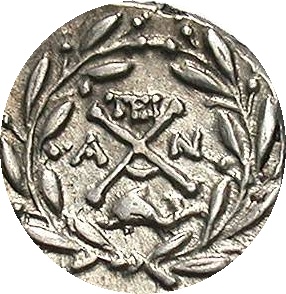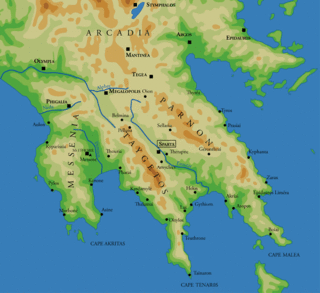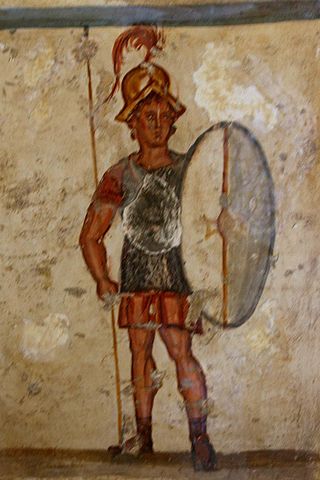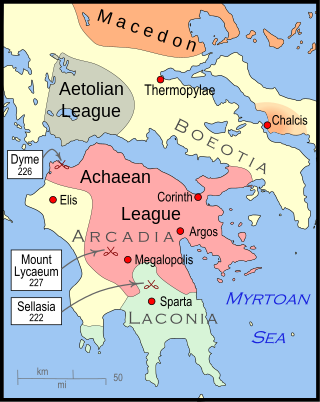
This article concerns the 200 BC decade, that lasted from 209 BC to 200 BC.
Year 207 BC was a year of the pre-Julian Roman calendar. At the time it was known as the Year of the Consulship of Nero and Salinator. The denomination 207 BC for this year has been used since the early medieval period, when the Anno Domini calendar era became the prevalent method in Europe for naming years.

Philip V was king of the ancient Greek kingdom of Macedon from 221 to 179 BC. Philip's reign was principally marked by the Social War in Greece and a struggle with the emerging power of the Roman Republic. He would lead Macedon against Rome in the First and Second Macedonian Wars. While he lost the latter, Philip later allied with Rome against Antiochus III in the Roman-Seleucid War. He died in 179 BC from illness after efforts to recover the military and economic condition of Macedonia and passed the throne onto his elder son, Perseus of Macedon.

Aetolia is a mountainous region of Greece on the north coast of the Gulf of Corinth, forming the eastern part of the modern regional unit of Aetolia-Acarnania.

Cleomenes III was one of the two kings of Sparta from 235 to 222 BC. He was a member of the Agiad dynasty and succeeded his father, Leonidas II. He is known for his attempts to reform the Spartan state.

The Achaean League was a Hellenistic-era confederation of Greek city-states on the northern and central Peloponnese. The league was named after the region of Achaea in the northwestern Peloponnese, which formed its original core. The first league was formed in the fifth century BC. The second Achaean League was established in 280 BC. As a rival of Antigonid Macedon and an ally of the Roman Republic, the league played a major role in the expansion of Rome into Greece. This process eventually led to the League's conquest and dissolution by the Romans in 146 BC.

Nabis was the last king of independent Sparta. He was probably a member of the Heracleidae, and he ruled from 207 BC to 192 BC, during the years of the First and Second Macedonian Wars and the eponymous "War against Nabis", i.e. against him. After taking the throne by executing two claimants, he began rebuilding Sparta's power. During the Second Macedonian War, Nabis sided with King Philip V of Macedon and in return he received the city of Argos. However, when the war began to turn against the Macedonians, he defected to Rome. After the war, the Romans, urged by the Achaean League, attacked Nabis and defeated him. He then was assassinated in 192 BC by the Aetolian League. He represented the last phase of Sparta's reformist period.

Philopoemen was a skilled Greek general and statesman, who was Achaean strategos on eight occasions.

The Battle of Sellasia took place during the summer of 222 BC between Macedon and the Achaean League, led by Antigonus III Doson, and Sparta under the command of King Cleomenes III. The battle was fought at Sellasia on the northern frontier of Laconia and ended in a Macedonian-Achaean victory.

Aratus of Sicyon was a politician and military commander of Hellenistic Greece. He was elected strategos of the Achaean League 17 times, leading the League through numerous military campaigns including the Cleomenean War and the Social War.

The thyreophoroi or thureophoroi were a type of infantry soldier, common in the 3rd to 1st centuries BC, who carried a large oval shield called a thyreos which had a type of metal strip boss and a central spine. They were armed with a long thrusting spear, javelins and a sword. They also usually wore an iron or bronze Macedonian helmet.

The Battle of Corinth of 146 BC, also known as the Battle of Leucapetra or the Battle of Lefkopetra, was a decisive engagement fought between the Roman Republic and the Greek city-state of Corinth and its allies in the Achaean League. The battle marked the end of the Achaean War and the beginning of the period of Roman domination in Greek history, and is also notable for the complete and total destruction of Corinth by the Romans in its aftermath.

The Laconian War of 195 BC was fought between the Greek city-state of Sparta and a coalition composed of Rome, the Achaean League, Pergamum, Rhodes, and Macedon.
The Hellenistic armies is a term that refers to the various armies of the successor kingdoms to the Hellenistic period, emerging soon after the death of Alexander the Great in 323 BCE, when the Macedonian empire was split between his successors, known as the Diadochi.
Machanidas was a tyrant of Lacedaemon near the end of the 3rd century BC. He was defeated and slain by Philopoemen.

The Cleomenean War was fought between Sparta and the Achaean League for the control of the Peloponnese. Under the leadership of king Cleomenes III, Sparta initially had the upper hand, which forced the Achaean League to call for help the Macedonian king Antigonos Doson, who decisively defeated Cleomenes in the battle of Sellasia in 222.

The Antigonid Macedonian army was the army that evolved from the ancient Greek kingdom of Macedonia in the period when it was ruled by the Antigonid dynasty from 276 BC to 168 BC. It was seen as one of the principal Hellenistic fighting forces until its ultimate defeat at Roman hands at the Battle of Pydna in 168 BC. However, there was a brief resurgence in 150-148 during the revolt of Andriscus, a supposed heir to Perseus.

The Achaean War of 146 BC was fought between the Roman Republic and the Greek Achaean League, an alliance of Achaean and other Peloponnesian states in ancient Greece. It was the final stage of Rome's conquest of mainland Greece, taking place just after the Fourth Macedonian War.

The Lyttian War was an internal conflict fought from around 220 BC to about 216 BC between two coalitions of Cretan city-states, led by Knossos and Polyrrhenia respectively. The events of the war are recorded by the historian Polybius. It is considered "the greatest war in Cretan history" during Antiquity.
Belemina, or Belmina (Βέλμινα), or Belbina (Βελβίνα), or Blenina (Βλένινα), was a town of ancient Laconia and ancient Arcadia, at the northwest frontier of the former, the territory of which was called Belminatis (Βελμινᾶτις). It was originally an Arcadian town, but was conquered by the Lacedaemonians at an early period, and annexed to their territory; although Pausanias does not believe this statement. After the Battle of Leuctra, Belemina was restored to Arcadia, reckoned to be part of Aegytis; most of its inhabitants were removed to the newly founded city of Megalopolis; and the place continued to be a dependency of the latter city. In the wars of the Achaean League, the Belminatis was a constant source of contention between the Spartans and Achaeans. Under Machanidas or Nabis, the tyrants of Sparta, the Belminatis was again annexed to Laconia; but upon the subjugation of Sparta by Philopoemen in 188 BCE, the Belminatis was once more annexed to the territory of Megalopolis. The Belminatis is a mountainous district, in which the Eurotas takes its rise from many springs. Belemina is said by Pausanias to have been 100 stadia from Pellana.














